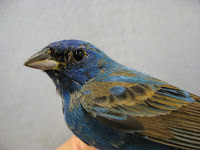Backing up the birds as they pass through Chicago
%5B1%5D.jpg)
%5B1%5D.jpg)

(POSTED: 11/30/09) It's 5:30 a.m. on a chilly Saturday, and while most folks remain comfortable in bed, a small band of volunteers make their way on foot through the Loop, scanning the sidewalks and bases of buildings.
Armed with paper bags and what appear to be butterfly nets, they are an odd sight -- but not a unique one.
Every day this is repeated, as members of the Chicago Bird Collision Monitors look for migrating birds that have run afoul of Chicago's skyscrapers and lay injured or dazed on the ground.
"The program initially only had a handful of people," the CBCM's director, Annette Prince, said recently in an interview with ChicagoWildlifeNews. "We'd have just one person go out per day and try to look for all the birds by themselves. Now we have over 100 volunteers."
Founded in 2003 by Robbie Hunsinger after she witnessed a particularly bloody night in the fall 2002 migratory season, the group is under the wing of the Chicago Audubon Society.
Prince, a language and speech pathologist by day, took over as director in 2005, and describes her volunteer work with the CBCM as "a job and a half."
But it's a labor of love, and more people seem to be embracing the cause.
"I think the awareness of the public has increased," Prince said. "They're making changes to help the birds and letting us know when they see injured birds. They have the eyes and ears that we need."
(There's a web site, and a hotline the public can use to report injured birds.)
A big change came in 2004 when the "Lights Out Chicago" initiative was started. Chicago was one of the first U.S. cities to have big buildings go temporarily dark during migration seasons, making it easier for migratory birds to identify glass windows as a solid surface -- and therefore avoid them.
Collisions, of course, still happen, which is why CBCM has a partnership with the Willowbrook Wildlife Center in the west suburbs. Injured birds are taken there for medical care and, hopefully, a release back into the wild.
Sandy Woltman, a wildlife specialist at Willowbrook, occasionally goes out on rounds to search for injured birds, but most of the time helps rehab them.
Birds can spend anywhere from a few hours to a few weeks at the center. "It depends on the injury," Woltman said. "If they have a fracture that needs to heal, it can be several weeks."
Once the birds are well, they are released to continue their migration.
The majority of the birds helped by CBCM are found in the downtown area, but the group's reach extends far beyond Chicago. Calls to the hotline come from all over -- including the Bahamas.
"It was pretty funny," Prince said of that long-distance call. "There was a woman who was in her condominium in the Bahamas and a bird hit the window of her patio." Prince was happy to provide guidance over the phone, and about an hour later the bird flew away safely.
But Chicago is the group's main focus.
Prince would love to see an ordinance passed here making it mandatory for downtown buildings to dim their lights during fall and spring migration seasons.
"Chicago sets an example," Prince said. "Cities like San Francisco, Boston and Baltimore have talked to us about light reduction programs. I think that making it an ordinance would be a fantastic way to say that this is the right thing to do."
For those interested in helping out the cause -- but not ready to disrupt Saturday- morning sleep -- even turning off lights at home or shutting the blinds can help, Prince said.
By Lindsey Malkus, for ChicagoWildlifeNews
Contact: [email protected]
Photos: Above birds were rescued by CBCM. Clockwise pictures: indigo bunting, blackburnian warbler, black-throated green warbler
%5B1%5D.jpg)
%5B1%5D.jpg)


0 comments: